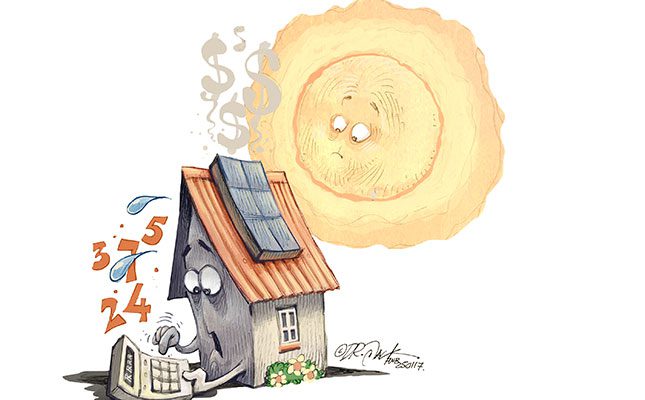
Solar power has emerged as the top choice for homeowners looking to reduce their grid electricity costs in the face of massive multiyear tariff hikes and escape the crippling impact of power outages as a result of crumbling municipal infrastructure.
Solar-energy subscriptions have been punted as a seemingly hassle-free way to access solar energy without the upfront costs or ongoing maintenance costs. While this might sound appealing, solar-energy subscriptions often prove to be very costly decisions.
There are many solar rental and ‘solar as a service’ subscription options that have sprung onto the market that promise the world, while a deeper delve into the contract fine print leaves you cold with hefty initiation fees, onerous annual escalations, ‘ever-green’ rental terms, hefty penalties for early cancellations, de-installation costs, and large ‘buy-out’ clauses to own the asset after the rental/subscription period is fulfilled.
When you do the calculations, many are simply not financially sound at all. It is crucial that you fully understand what you are signing up for, as well as the differences between solar asset finance, rental and subscription offerings.
There are very important aspects to interrogate and understand before going into any solar rental or subscription agreement, and also what your alternatives are.
One Energy provides a helpful checklist of why solar subscriptions might not be the best financial option. The list is as follows:
1. No ownership and no equity
When you opt for a solar-power subscription or rental, you do not own the system installed on your property. Ever. Instead, the solar company retains ownership, and you essentially subscribe to a certain amount of power per month.
This arrangement means that any potential increase in your property value due to the solar installation does not benefit you. Unlike buying solar panels, which allows you to build equity, renting leaves you without an asset at the end of the lease term.
Essentially, all you’re doing is deferring the money you would be paying to the council or Eskom to another entity.
Ultimately, you aren’t investing in a long-term solution to reduce your grid dependence and usage – it’s a pure consumption expense with zero investment value.
2. Long-term contracts and escalating costs
While solar rentals/subscriptions may avoid the upfront cost of purchasing a solar-power system, they typically end up being more expensive in the long run. Monthly payments usually accumulate to a higher total cost over the lease period, which typically spans at least five years.
Additionally, rental agreements mostly include annual escalation clauses, further eroding the expected savings and making it difficult to predict the true financial benefit over the lease term.
It makes little financial sense to pay for solar-supplied energy (kW) where the rental/subscription costs increase annually by around 7%, alongside Eskom’s charges that increase every year by 12% to 15%.
Unless your rented solar-power system is sized to reduce your grid usage by at least 90%, you could be in a world of pain, with your solar-supplied power costing you much more after two to three years of escalations than when you began.
For example, consider a monthly rental payment of R1 500 in year one, which escalates by 7% compounded. By year five, you will be paying around R2 300 monthly, almost R800 more per month, with no asset to show for it!
In one particular case, we took a subscription package and analysed what such a system would generate in terms of kW per day – in this particular example, it was 25kW – multiplied this by 30 to get the monthly generation capacity (750kW), and then divided this by the monthly rental amount. The cost per kW was R3,80 – higher than the current Eskom/council cost per kW!
This cost then increases by 7% every year, for the same amount of generation. Add the escalating costs of the grid-supplied portion of your monthly usage, and you could find yourself on the receiving end of a horribly expensive cost per kWh, and locked into an expensive rental contract with hefty cancellation penalties.
3. Early cancellation penalties and hefty ‘buy-out’ clauses
If you need to cancel your rental agreement early or want to exercise your option to buy the system, you may face hefty penalties and buy-out fees, over and above what you have already paid.
Carefully review penalty fees for early cancellation, or if you want to buy your system (if it’s even an option) – these vary from supplier to supplier but can be onerous.
Interrogate all the terms and conditions before signing up – ask for a sample contract, do your calculations, and make sure you fully understand the implications of the terms and conditions.
4. Transfer complications
Selling a home with a solar rental agreement can be complicated. Prospective buyers must be willing to take over the lease terms, which might not always be appealing. This can limit your pool of potential buyers, or force you to buy out the lease at a significant penalty cost to facilitate the sale.
In contrast, owning a quality solar-power system – which has a good 15- to 20-year productive lifespan – can significantly increase your home’s market value and appeal.
5. Maintenance and performance issues
While the solar rental company typically handles maintenance under a rental agreement, renters may face challenges if the service is subpar. Performance issues or delays in maintenance can result in higher energy bills, reducing the anticipated financial benefits.
Is the solar subscription provider a solar installation specialist with in-house technical expertise and qualified service teams, or are they simply an aggregator that outsources the installation to a panel of independent solar installation partners?
It may not seem important upfront, but down the line when you need service and backup support for a technical or warranty issue, this can be a significant sticking point as to who services your needs.
Furthermore, some subscription options limit the level of battery power you can access (the depth of discharge) in a bid to protect the battery life for future usage in other rentals. So instead of having 90% of your battery capacity available, you are limited to 70%, which further reduces your savings and pushes up your costs.
With ownership, you have more control over maintenance quality and can ensure that the system operates at peak efficiency for your needs.
6. Limited financial incentives
If you’re on a solar subscription, it is the solar subscription company and not you as the homeowner who owns the equipment, so any benefit on rebates and tax incentives goes back to the equipment owner and not to you.
Homeowners who purchase their solar-power systems can claim these incentives directly, including the benefits of feed-in tariffs where available, significantly reducing the net cost of their investments.
The big question to ask yourself is this: why would you want to pay a monthly premium for five years or more, for pure-consumption kW, when you can actually own the solar asset that will be productive for another 15-plus years and save you a fortune on future electricity bills?
If you are looking to get your electricity at a cheaper rate than what you can buy from your council or Eskom, then an ever-increasing solar subscription completely defeats this objective. While these deals may sound cheap to start off with, they rapidly escalate as the years go by.
Remember that you are also still likely to be drawing some electricity from the grid as it is
very unlikely that you will be off-grid completely.
Given that electricity prices are likely to increase by at least 20% per annum for the foreseeable future, and if your monthly solar rental increases each year by 7%, you could be facing a serious financial liability.
Finance alternatives to consider
A quality hybrid solar inverter with batteries and panels has a good 15- to 20-year lifespan, so ideally you want to take full ownership of your system – or pay it off quickly – so you get the best return on investment.
If you finance your system, for example, and pay it off over five years or less, you have another 10 to 15 years more of free electricity production from your solar-power system. If the upfront cost of purchasing solar panels is a concern, there are alternatives to consider, such as:
- Solar finance. This allows you to finance the purchase of your solar-power system, in much the same way as you would finance a vehicle, providing the benefits of ownership without the full upfront cost. In many instances the monthly payments are significantly offset by the savings on your current electricity bill, leading to immediate savings.
For example, solar finance through Nedbank MFC offers asset finance for solar from bank-approved solar installers. Once you have a quotation and proposal from One Energy, you apply for finance over a fixed term (up to 96 months) and, based on your credit rating, you will be offered a finance solution linked to the prime interest rate.
Your monthly instalments are linked to the interest rate and there is no annual increase. You know exactly what you are in for and can budget accordingly. At the end of the finance term, you fully own your system and there is no buy-out fee required. - Rent-to-own. This is another option for individuals and businesses but with a caveat
– not all rent-to-own contract terms and conditions are the same. Check that there is no annual escalation clause and that you fully own your system at the end of the contract term – ideally with one single additional monthly rental instalment only rather than hefty buy-out fees – and that there are no penalties if you want to settle your rent-to-own term earlier. - Bond. If you have surplus cash in your home loan/bond, this is a good option, but not if you’re going to extend the bond to pay it off over 20 years, as the interest on your solar purchase over an extended period makes this a costly financial decision.
While solar-power subscriptions may seem like a convenient and cost-effective
way to go green, they often fall short financially when compared with purchasing or other financing options.
As with any major financial decision, it’s crucial to carefully evaluate all the options and consider the long-term implications to ensure you make the best choice for your circumstances.











